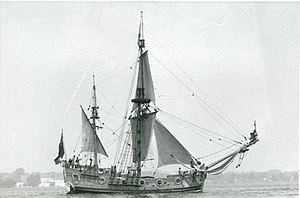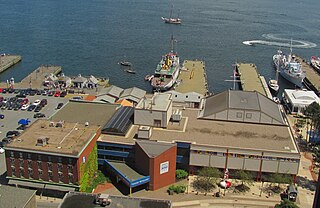
The Maritime Museum of the Atlantic is a maritime museum located in downtown Halifax, Nova Scotia, Canada.

The RRS Discovery is a barque-rigged auxiliary steamship built in Dundee, Scotland for Antarctic research. Launched in 1901, she was the last traditional wooden three-masted ship to be built in the United Kingdom. Her first mission was the British National Antarctic Expedition, carrying Robert Falcon Scott and Ernest Shackleton on their first, and highly successful, journey to the Antarctic, known as the Discovery Expedition.
Médard Chouart des Groseilliers (1618–1696) was a French explorer and fur trader in Canada. He is often paired with his brother-in-law Pierre-Esprit Radisson, who was about 20 years younger. The pair worked together in fur trading and exploration. Their decision to enter British service led to the foundation of the Hudson's Bay Company in 1670. This company established trading posts and extensive relations with the First Nations in western Canada. It was highly influential in making the region amenable to British colonization. Radisson, with Groseiliers, also mapped many of the Great Lakes and trading routes used by settlers.

Golden Hind was a galleon captained by Francis Drake in his circumnavigation of the world between 1577 and 1580. She was originally known as Pelican, but Drake renamed her mid-voyage in 1578, in honour of his patron, Sir Christopher Hatton, whose crest was a golden hind. Hatton was one of the principal sponsors of Drake's world voyage. A full-sized, seaworthy reconstruction is in London, on the south bank of the Thames.
Several vessels of the Royal Navy have been named HMS Nonsuch, presumably named after Nonsuch Palace:

York Factory was a settlement and Hudson's Bay Company (HBC) factory located on the southwestern shore of Hudson Bay in northeastern Manitoba, Canada, at the mouth of the Hayes River, approximately 200 kilometres (120 mi) south-southeast of Churchill. York Factory was one of the first fur-trading posts established by the HBC, built in 1684 and used in that business for more than 270 years. The settlement was headquarters of the HBC's Northern Department from 1821 to 1873. The complex was designated a National Historic Site of Canada in 1936.

Discovery or Discoverie was a small 20-ton, 38-foot (12 m) long "fly-boat" of the British East India Company, launched before 1602. It was one of the three ships on the 1606–1607 voyage to the New World for the English Virginia Company of London. The journey resulted in the founding of Jamestown in the new Colony of Virginia.

The Pélican was a French warship from the late 17th century. Built in Bayonne, France, the original Pélican was launched in January 1693. A 500-ton ship fitted with 50 guns and commanded by Captain Pierre Le Moyne d'Iberville, she ran aground on the shores of Hudson Bay a few days after a heroic battle in 1697, badly damaged by the encounter and by a fierce storm. In five short months the ship's place in history had been assured, as the victor in the greatest naval battle in the history of New France.

The Manitoba Museum, previously the Manitoba Museum of Man and Nature, is a human and natural history museum in Winnipeg, Manitoba, as well as the province's largest, not-for-profit centre for heritage and science education.
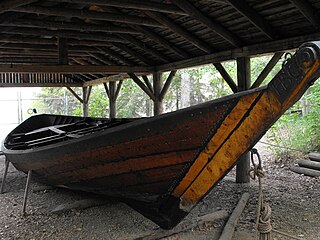
The York boat was a type of inland boat used by the Hudson's Bay Company to carry furs and trade goods along inland waterways in Rupert's Land, the watershed stretching from Hudson Bay to the eastern slopes of the Rocky Mountains. It was named after York Factory, the headquarters of the HBC, and modeled after the Orkney yole. Two variations to the York Boat were scows and "Sturgeon Heads."
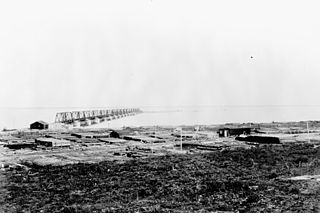
Port Nelson was a settlement on Hudson Bay, in Manitoba, Canada, at the mouth of the Nelson River. Its peak population in the early 20th century was about 1,000 people but today it is a ghost town. Immediately to the south-southeast is the mouth of the Hayes River and the settlement of York Factory. Note that some books use 'Port Nelson' to mean the region around the mouths of the two rivers.

USS Coronis (ARL-10) was one of 39 Achelous-class repair ship landing craft built for the United States Navy during World War II. Named for Coronis, she was the only US Naval vessel to bear the name.

The Mackenzie River in Canada's Northwest Territories is a historic waterway, used for centuries by Indigenous peoples, specifically the Dene, as a travel and hunting corridor. Also known as the Deh Cho, it is part of a larger watershed that includes the Slave, Athabasca, and Peace rivers extending from northern Alberta. In the 1780s, Peter Pond, a trader with the North West Company became the first known European to visit this watershed and begin viable trade with the Athapascan-speaking Dene of these rivers. The Mackenzie River itself, the great waterway extending to the Arctic Ocean, was first put on European maps by Alexander Mackenzie in 1789, the Scottish trader who explored the river. The watershed thus became a vital part of the North American fur trade, and before the advent of the airplane or road networks, the river was the only communication link between northern trading posts and the south. Water travel increased in the late 19th century as traders, dominated primarily by the Hudson's Bay Company (HBC), looked to increase water services in the Mackenzie River District.
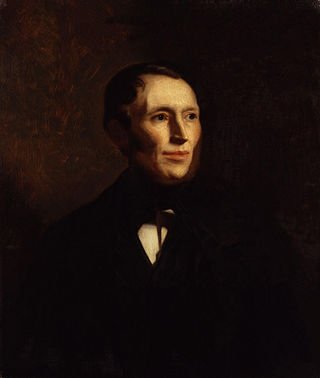
William Kennedy was a Canadian fur trader, politician, and historian.
Zachariah Gillam (1636–1682) was one of a family of New England sea captains involved in the early days of the Hudson's Bay Company.

Aklavik was a small cargo vessel the Hudson's Bay Company used to carry supplies to, and furs from, its outposts in the high Arctic. She was active in the first half of the 20th century.

Prince of Wales was launched in 1793 on the Thames. She spent much of her career sailing for the Hudson's Bay Company (HBC). From 1845 she was a Greenland whaler, sailing out of Hull. In 1845 she was the last ship to see Sir John Franklin's expedition to the arctic. She was wrecked on 12 June 1849 in Davis Strait.
Queen Charlotte was built on the Thames in 1790. She made eight voyages for the Hudson's Bay Company (HBC) before it sold her in 1800. She then traded to South America and the Mediterranean. In 1803 her crew mutinied and turned her over to the French, who promptly handed her and them back to the British authorities, despite the two countries being at war. She then spent much of her career sailing between London and the Cape of Good Hope. She was sailing for the Cape in October 1813 when a collision with another vessel resulted in Queen Charlotte being wrecked shortly thereafter.
William and Ann was launched in Bermuda in 1818. In 1824 the Hudson's Bay Company (HBC) purchased William and Ann. In 1825 she became the first HBC vessel to trade with the Pacific Northwest, competing directly with the Boston fur traders. She made three voyages to Fort George on the Columbia River, and was lost on 10 March 1829 on her fourth as she was arriving there.
Sea Horse was launched in 1782 at Gravesend for the Hudson Bay Company. She then became a merchantman that a French naval squadron captured in 1795. She next became the Spanish merchantman Principe Fernando, which a Guernsey privateer recaptured in January 1800. She became a merchantman again, and then made one voyage as a whaler. She became a Government transport and it was as a transport that she was wrecked in 1816 with great loss of life.
